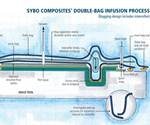Single vs. double-bagged infusion
Russell Emanis (JB Martin, St.
Share
Russell Emanis (JB Martin, St. Jean Sur Richelieu, Quebec, Canada) demonstrated the effectiveness of his double-bagging technique by performing side-by-side single- and double-bag trials. Samples were sent to DIAB (DeSoto, Texas). The latter donated fiber volume burn-out tests that yielded fiber contents of 69.45 percent and 67.39 percent for the lightweight and heavy laminates, respectively. Test details follow.
Four 5 inch by 20 inch (127 mm by 508 mm) test panels, two heavy and two lightweight fiberglass laminates, were infused with 4281 ambient cure epoxy supplied by Endurance Technologies (St. Paul, Minn.). The lightweight laminates consisted of two plies of JB Martin’s TG22N50 22-oz/yd² biaxial fabric on either side of one ply TG54N50 54-oz/yd² biaxial, while the heavy laminates used a two-ply layer of TG22N50 three times with one ply of TG54N50 in between for a total of 8-plies.
All four parts were bagged individually for infusion. A second bag was installed over one heavy and one lightweight panel, with a vent material between the inner and outer bags. Prior to infusion a 2.5-hour debulk at full available vacuum pressure of 28.9 in. Hg (982 mbar) also served to remove ambient moisture. The four test panels were infused simultaneously using a single vacuum pump system with 4-outlet catch pot supplied by Vacmobiles (Auckland, New Zealand). Infusion vacuum pressure in the inner bag was set at 26.0 in. Hg (880 mbar). The initial resin flow rate of 3 inches/min slowed to 1 inch/min after 20 inches of travel. Vacuum in the inner bag was measured using a liquid-filled, vented Mercury gauge, because vacuum here was merely to achieve infusion and measurement did not need to be as precise as in the outer bag, where compaction pressure determined fiber volume. The outer vacuum bags on the two double-bagged test panels were evacuated by a second Vacmobiles system fitted with a second vented mercury gauge as well as a Vacmobiles digital absolute vacuum gage. Resin feed lines were shut off via valves sequentially, all within 30 seconds, and then full available vacuum pressure was applied to the two outer bags. Emanis observed resin flow out of the double-bagged parts from both vacuum and resin feed inlets. He monitored the process through gelation. The parts cured under vacuum overnight. The room, the mold, the laminate stack, vacuum materials, and epoxy and hardener, were all normalized to 73˚F/23˚C prior to infusion. Results are shown in the table at right.
Related Content
-
Materials & Processes: Fabrication methods
There are numerous methods for fabricating composite components. Selection of a method for a particular part, therefore, will depend on the materials, the part design and end-use or application. Here's a guide to selection.
-
Price, performance, protection: EV battery enclosures, Part 1
Composite technologies are growing in use as suppliers continue efforts to meet more demanding requirements for EV battery enclosures.
-
Sulapac introduces Sulapac Flow 1.7 to replace PLA, ABS and PP in FDM, FGF
Available as filament and granules for extrusion, new wood composite matches properties yet is compostable, eliminates microplastics and reduces carbon footprint.











